Jim Wiechmann’s Gothic Mansion
The real estate tycoon and owner of Stevens Point Brewery has one of the grandest mansions in town.

Jim Wiechmann’s Upper East Side Home.
The 1896 mansion owned by Jim Wiechmann was the first home constructed on grand E. Newberry Boulevard, though it was left unfinished by Atty. Benjamin M. Goldberg, who ran out of money after being disbarred for 19 charges of “compounding felonies, extortion, blackmail and false testimony.” Nowhere in the nation had there been a disbarment proceeding “where an attorney stood charged with a series of such grave offenses,” said a report of the time [1897]. Here is a 19th century example of a phenomenon that still stings in the 21st century — real estate speculation gone wild, an investor in over his head, a showy mansion incomplete.
Goldberg had a $30,000 budget for the construction of the home, which he apparently financed with a series of rackets in Waushara County, where he once served as District Attorney while practicing law in Milwaukee and serving as Attorney for the new city of South Milwaukee, incorporated in 1892. He built his ephemeral fortune by extorting small sums from victims by threatening lawsuit by unnamed parties and other sharp practices. In one case, he got $50 threatening to sue a man that he heard had had a dalliance with another’s wife, claiming to represent the aggrieved husband.
The residence financed by this petty piker and finished by the succeeding owner was described by Judith Knuth in the Milwaukee Journal in 1987 as “bustling with crockets and finials, awash in tracery, balustraded to a fare-thee-well, its Gothic elements … nearly overpowered by the ample proportions of its plump Victorian bays and porches.”
Since 1980 it has been the home of real estate investor Jim Wiechmann and his wife Susan Wiechmann, and has been featured in magazine articles, was the site of the Historic Milwaukee “Over the Top!” fundraiser in 2011, and served as a stop when Antiques Roadshow was in town taking a look at the world’s largest collection of posters by Jules Cheret, which hangs on the Wiechmanns walls when not on loan to art museums.
It truly is a grand estate, with 6,826 sq. ft. spread over two floors and a finished, 1,348 sq. ft. attic. There are seven bedrooms in the residence, along with 3-1/2 baths. It is kept toasty in season by warm air heating, and is cooled in the summer by the gentle breezes of Lake Michigan and the occasional window air-conditioning unit. Why, even some of Wiechmann’s tenants enjoy central air-conditioning, but not this humble citizen! The half-bath is located on the first floor, an extreme rarity at the time. Another example is in the Kalvelage Schloss, constructed for a plumbing contractor who likely supplied the Goldberg mansion.
The auxiliary home — no mere couch house — itself has 2,621 sq. ft., but with just two bedrooms and a single bathroom. Both edifices sit on a corner lot that’s 90 ft. by 150 ft. The city assesses the land at $125,000 and the improvements at $1,121,900 for a total of $1,246,900. Taxes are $37,157.67, and the Wiechmanns have paid their bill in full. The Wiechmanns transferred the deed to the home to their revocable trust in December, 2010, at a value of $1,375,000.
E. Newberry Boulevard was recognized in 2009 as one of America’s 10 “Great Streets” by the American Planning Association, joining such noted thoroughfares as Broadway Street in Skagway, Alaska, Haddon Avenue in Collingswood, New Jersey, and President Clinton Avenue in Little Rock, Arkansas. It was added to the National Register of Historic Places on March 7th, 2004. Ald. Nik Kovac used to play football on the ample median, as a youth, using the trees as handy goal markers. Now it is but one part of his vast domain.
The Rundown
- Style : Victorian Gothic
- Subdivision: Prospect Hill
- Neighborhood: Northpoint / Upper East Side
- Walkscore: 85 out of 100. “Very walkable” — just two blocks from Sendik’s and Downer Avenue Wine & Spirits. The Bronze Fonz is a hearty 2.64 mile walk away. [The carriage house, with a N. Summit Ave. address has a 91 “Walker’s Paradise” score.]
- Public Transit Score: 57 out of 100. “Good Transit.” Just 521 feet away from the #21 North Avenue bus, which opens up the world to Wiechmann, at least as far west as Mayfair Mall.
- Street Smart Walkscore: 86 out of 100.
- Size: 9,447 sq ft., including the 2,621 sq. ft. carriage house.
- Year Built: 1896
- Assessed Value: $1,246,900
How Milwaukee is it? Distance to City Hall about 3 miles on foot, a leisurely 4 miles by auto on scenic N. Lincoln Memorial Drive.
Fun Fact: According to city records, this giant home has no fireplaces. That is, no wood-burning fireplaces. In fact it has 8 gas-fired fireplaces. These devices, new to the era, joined such other nowaday commonplaces as indoor plumbing, central heating, gas stoves, electricity, and telephones in residential construction, especially of the luxury sort.
It was thought that a wood-burning fireplace signaled a home that relied on outdated technology. A home with a wood-burning fireplace might as well have chamber pots in the bedrooms, a privy in the back yard, a pump in the front, whale oil lamps and maids hauling slops in buckets. It was not until around the turn of the century that wood-burning fireplaces regained their vogue. [Wisconsin native Frank Lloyd Wright had a lot to do with that.]
Some of the home’s chandeliers were melted down into ammunition in World War I. These were of the now-rare combination gas-electric style, bought by those hedging their bets that electric lighting was a passing fad.
What Happened to Goldberg? After being disbarred in Wisconsin, Benjamin M. Goldberg became a Chicago attorney, where his crimes did not fall beneath the standards of his profession as practiced there. He was arrested in Wisconsin in 1904 for passing a bad $50 check.
Photo Gallery
About Jim Wiechmann
James Lester Wiechmann is the founder and president of Wiechmann Enterprises, LLC. A list of Wiechmann’s properties occupies several pages on the internet, with extensive holdings in the UWM neighborhoods not far from his home, where the firm operates out of basement office space, using its N. Summit Ave. address.
Wiechmann is a graduate “with honors” of The Milwaukee School of Engineering. He worked as an engineer at Ladish Corp. and elsewhere, discovering that his engineering skills would transfer nicely to the field of real estate, with its myriad complications and systems created by architects and left for engineers to maintain and fix.
In 1991, the Wiechmanns were the first to bring picnic baskets and portable chairs to Jazz in the Park. The baskets were overflowing with wines and cheeses, and the chairs were overflowing with sated guests.
Once everybody started bringing in wine and chairs, Jim Wiechmann set up a table in the northwest corner of Cathedral Square during Jazz in the Park, supplying friends with cigars from his stash and free beer from the Stevens Point Brewery, which he and partner Joe Martino bought in 2002. Infusion of over $4 million in capital improvements brought the brewery to a 2012 capacity of 120,000 barrels. A fourth expansion, announced in January, 2013, is to cost $2 million and will bring the brewery’s capacity to 150,000 barrels when completed in May, 2013.
When Jazz in the Park management cracked down on carry-ins, Wiechmann made himself scarce from that event. But you can still find him out and about. To this day, Wiechmann is known for hanging around some of Milwaukee’s more colorful places. He and his associates, often younger men just getting into real estate, would spend long Saturday afternoons at the Five and Ten tavern (now Brocach Irish Pub) sipping beverages, smoking big cigars and trading tales. The ubiquity of Point beers on tap at Club Charlie’s in the Third Ward is testament to Wiechmann’s frequent visits there, and he is a reliable fixture Thursday evenings at Shakers Cigar Bar where he and his cronies, including investors Joel Lee and John Savage, hang out and tell their stories from the near end of a burning stogy. Wiechmann just leased a property at 1632 N. Water Street to Dan Fitzgibbons who plans to turn the old O’Brady’s into The Curve, a dive bar of just the sort that would appeal to this man-of-the-people landlord.
Political Contributions Tracker
Displaying political contributions between people mentioned in this story. Learn more.
- July 8, 2019 - Nik Kovac received $200 from Jim Wiechmann
- February 10, 2016 - Nik Kovac received $200 from Jim Wiechmann
House Confidential Database
| Name | City | Assessment | Walk Score | Year |
|---|---|---|---|---|
| Name | City | Assessment | Walk Score | Year |


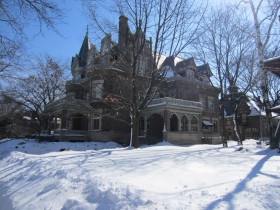
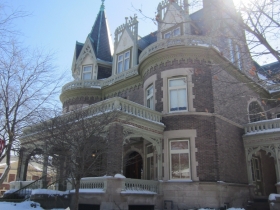
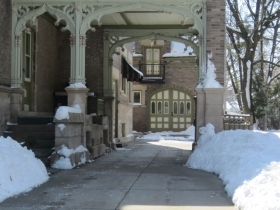
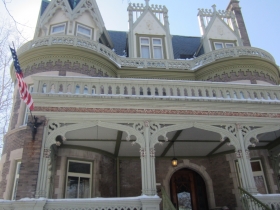
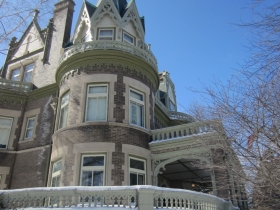
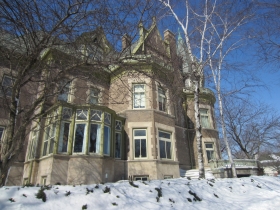


















In my days at UWSP in the 70’s the slogan for Point beer was “If you’re out of Point, you’re out of town”.
Thanks for the article! Coincidentally, just a few days ago I was looking on the web for information on this house. I used to drive by it frequently and thought it one of the most interesting homes around.
Thanks for your comment, Steve. Jim Wiechmann had this home in his sights since 1960. It was occupied for years by Mrs. Wald. I was so curious about the place in the late 1970s that I knocked on the door asking if I could mow the lawn, or prune the shrubs, but she was kind of out of it, I am afraid.
Michael,
I had the good fortune to grow up in one of those five Lake Drive homes your refer to that were built before 1898. That house was designed by Ferry & Clas and built the same year as the Milwaukee Public Library, also by F&C.
Too bad you don’t reference the architect on Wiechmann’s place. I believe it was Otto Buemming, who specialized in that sort of Victorian wedding cakes style. His work can be seen throughout the Northpoint-North and South historic districts and of course in the Concordia neighborhood and Brewer’s Hill.
The Goldberg house was a decrepit mess throughout my childhood, when , as you note, Mrs Wald was in residence. Nonetheless, it was known locally as the “Whatahouse.”
Jim Wiechmann has been a faithful steward of this local treasure for many years. He is to be commended.
Dear Bill Kissinger:
The architecture is credited to John A. Moller and George C Ehlers. Pardon my oversight. I will include architect names, when they can be determined, in the future.
Michael,
Thanks for the correction. It gives me an excuse to correct myself, since I meant Herman Buemming, anyway. Moller & Ehlers is a pretty obscure credit. To my knowledge not among the most fashionable of choices. Based on your profile of Goldberg, probably someone he could blackmail.
I actually used to live in the carriage house when my mom rented it for about two years. It was charming and comfortable but in a little dit of disrepair (it was built in the 19th century so that is to be expected). The floors slanted but I loved the place. I do miss it. The carriage house had an awesome carriage lift which sure helped moving in and out and just having a little fun riding it up and down!
Love this –
“Now it is but one part of his vast domain.”
What fun to find the information on this mansion! Attorney BM Goldberg and his wife Loretta bought a house from
Rodney Gillett, founder of Gillett Wisconsin. He lived in Gillett about 4 years, and was involved in serveral “incidences” according to the local papers! His house burned to the ground and he sold the land to my Grandfather Walter W. Smith.
The abstract reads like a soap opera! I researched his escapades in Wisconsin, and put together a good size booklet.
He eventually moved to Duluth MN, and practiced law there. He died December 19 1927 in Duluth.
Hope there is a tour offered of the Milwauee home sometime soon!